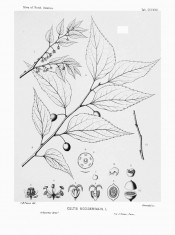Celtis occidentalis L.
Fully hardy, spreading, deciduous tree with lance-shaped, sharply-toothed leaves, rounded or heart-shaped at the base, and sweet, edible, yellow or red fruit, to 1cm across, ripening to purple. To 20m. [RHSE, Hortus, Hilliers’].
Horticultural & Botanical History
‘In Canada, where Celtis occidentalis is exceedingly rare and local, it is distributed from Saint Helen’s Island in the St. Lawrence River, near Montreal, westward to southern Ontario, and in the United States from the shores of Massachusetts Bay to northwestern Nebraska, North Dakota, southern Idaho, eastern Washington and Oregon, western Washington, the East Humboldt Mountains of Nevada, New Mexico, and southward to the shores of Bay Biscayne and Cape Romano in Florida, and to Missouri, eastern Kansas, Arkansas, the Indian Territory, and eastern Texas. Rare east of the Hudson River, Celtis occidentalis becomes more abundant in western New York and the middle states, and attains its greatest size on the rich bottom-lands of the lower Ohio basin, where it is one of the commonest trees in the forests of Oaks, Hickories, and Walnuts; it grows usually in rich moist soil, and often, especially in the east, on dry gravelly or rocky hillsides. West of the Rocky Mountains it is exceedingly rare, and is confined to the banks of streams in positions where it is frequently inundated during periods of high water, and where it is a small tree or shrub rarely thirty feet tall, with thick rigid scabrous conspicuously reticulate leaves. On the rocky banks of streams a dwarf shrubby form with stems four to ten feet tall and small usually rugose leaves is not uncommon in the south Atlantic states, from which it ranges westward to Missouri, Colorado, Utah, and Nevada.
The wood of Celtis occidentalis is heavy, rather soft, not strong, and coarse-grained, containing bands of several rows of large open ducts marking the layers of annual growth, numerous small groups of smaller ducts arranged in intermediate concentric rings, and many thin medullary rays; it is clear light yellow, with thick lighter colored sapwood. The specific gravity of the absolutely dry wood is 0.7287, a cubic foot weighing 45.41 pounds. It is largely used for fencing and for cheap furniture.
Celtis occidentalis was introduced into English gardens by the younger Tradescant about the middle of the seventeenth century, and the first description of it, made from a plant cultivated in England, was published in 1688 in Ray’s Historia Plantarum.’ [Silva of North America vol.7, pl.CCCXVII/1895].
Introduced to Europe in 1656. [PD].
History at Camden Park
Listed in all published catalogues [T.290/1843], established in the gardens and somewhat of a weed in the surrounding countryside.
Notes
Published Mar 05, 2009 - 04:26 PM | Last updated Feb 28, 2010 - 01:56 PM
| Family | Ulmaceae |
|---|---|
| Category | |
| Region of origin | North America |
| Synonyms |
|
| Common Name | Hackberry, Sugarberry |
| Name in the Camden Park Record | Celtis occidentalis |
| Confidence level | high |


